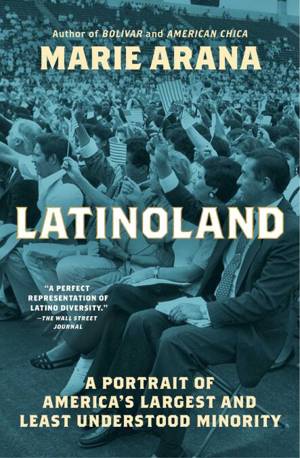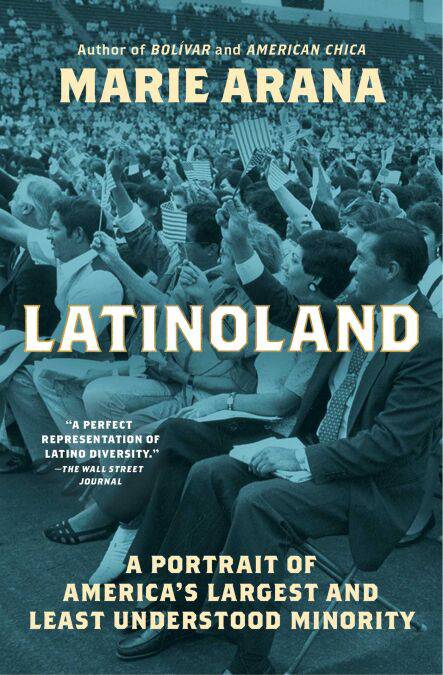
- Afhalen na 1 uur in een winkel met voorraad
- Gratis thuislevering in België vanaf € 30
- Ruim aanbod met 7 miljoen producten
- Afhalen na 1 uur in een winkel met voorraad
- Gratis thuislevering in België vanaf € 30
- Ruim aanbod met 7 miljoen producten
Zoeken
LatinoLand E-BOOK
A Portrait of America's Largest and Least Understood Minority
Marie Arana
E-book | Engels
€ 19,00
+ 19 punten
Uitvoering
Omschrijving
“A perfect representation of Latino diversity” (The Washington Post), LatinoLand draws from hundreds of interviews and prodigious research to give us both a vibrant portrait and the little-known history of our largest and fastest-growing minority, in “a work of prophecy, sympathy, and courage” (Junot Díaz, Pulitzer Prize–winning author).
LatinoLand is an exceptional, all-encompassing overview of Hispanic America based on personal interviews, deep research, and Marie Arana’s life experience as a Latina. At present, Latinos comprise twenty percent of the US population, a number that is growing. By 2050, census reports project that one in every three Americans will claim Latino heritage.
But Latinos are not a monolith. They do not represent a single group. The largest groups are Mexicans, Puerto Ricans, Dominicans, Salvadorans, and Cubans. Each has a different cultural and political background. Puerto Ricans, for example, are US citizens, whereas some Mexican Americans never immigrated because the US-Mexico border shifted after the US invasion of 1848, incorporating what is now the entire southwest of the United States. Cubans came in two great waves: those escaping communism in the early years of Castro, many of whom were professionals and wealthy, and those permitted to leave in the Mariel boat lift twenty years later, representing some of the poorest Cubans, including prisoners.
As LatinoLand shows, Latinos were some of the earliest immigrants to what is now the US—some of them arriving in the 1500s. They are racially diverse—a random infusion of white, Black, indigenous, and Asian. Once overwhelmingly Catholic, they are becoming increasingly Protestant and Evangelical. They range from domestic workers and day laborers to successful artists, corporate CEOs, and US senators. Formerly solidly Democratic, they now vote Republican in growing numbers. They are as culturally varied as any immigrants from Europe or Asia.
Marie Arana draws on her own experience as the daughter of an American mother and Peruvian father who came to the US at age nine, straddling two worlds, as many Latinos do. “Thorough, accessible, and necessary” (Ms. magazine), LatinoLand unabashedly celebrates Latino resilience and character and shows us why we must understand the fastest-growing minority in America.
LatinoLand is an exceptional, all-encompassing overview of Hispanic America based on personal interviews, deep research, and Marie Arana’s life experience as a Latina. At present, Latinos comprise twenty percent of the US population, a number that is growing. By 2050, census reports project that one in every three Americans will claim Latino heritage.
But Latinos are not a monolith. They do not represent a single group. The largest groups are Mexicans, Puerto Ricans, Dominicans, Salvadorans, and Cubans. Each has a different cultural and political background. Puerto Ricans, for example, are US citizens, whereas some Mexican Americans never immigrated because the US-Mexico border shifted after the US invasion of 1848, incorporating what is now the entire southwest of the United States. Cubans came in two great waves: those escaping communism in the early years of Castro, many of whom were professionals and wealthy, and those permitted to leave in the Mariel boat lift twenty years later, representing some of the poorest Cubans, including prisoners.
As LatinoLand shows, Latinos were some of the earliest immigrants to what is now the US—some of them arriving in the 1500s. They are racially diverse—a random infusion of white, Black, indigenous, and Asian. Once overwhelmingly Catholic, they are becoming increasingly Protestant and Evangelical. They range from domestic workers and day laborers to successful artists, corporate CEOs, and US senators. Formerly solidly Democratic, they now vote Republican in growing numbers. They are as culturally varied as any immigrants from Europe or Asia.
Marie Arana draws on her own experience as the daughter of an American mother and Peruvian father who came to the US at age nine, straddling two worlds, as many Latinos do. “Thorough, accessible, and necessary” (Ms. magazine), LatinoLand unabashedly celebrates Latino resilience and character and shows us why we must understand the fastest-growing minority in America.
Specificaties
Betrokkenen
- Auteur(s):
- Uitgeverij:
Inhoud
- Aantal bladzijden:
- 576
- Taal:
- Engels
Eigenschappen
- Productcode (EAN):
- 9781982184919
- Verschijningsdatum:
- 19/02/2024
- Uitvoering:
- E-book
- Beveiligd met:
- Adobe DRM
- Formaat:
- ePub

Alleen bij Standaard Boekhandel
+ 19 punten op je klantenkaart van Standaard Boekhandel
Beoordelingen
We publiceren alleen reviews die voldoen aan de voorwaarden voor reviews. Bekijk onze voorwaarden voor reviews.











